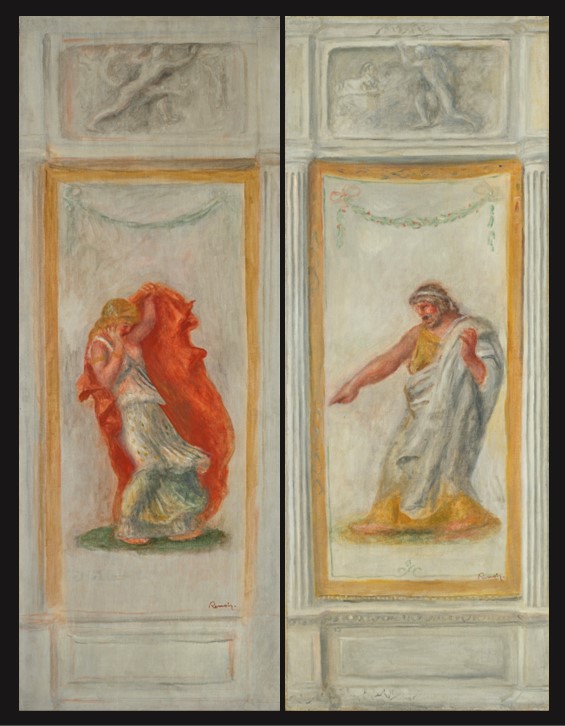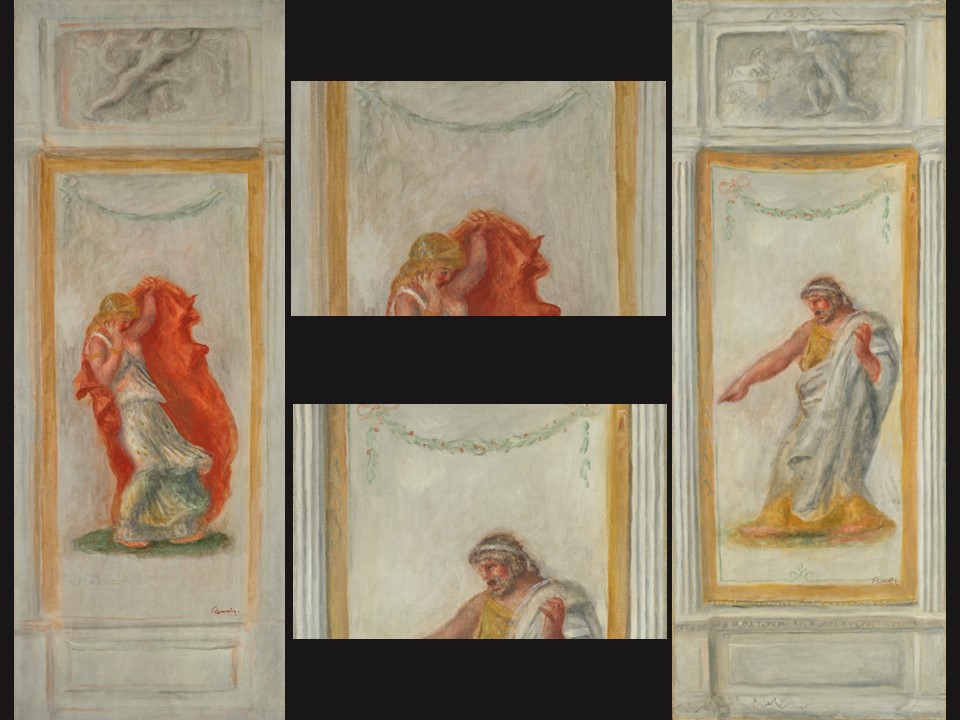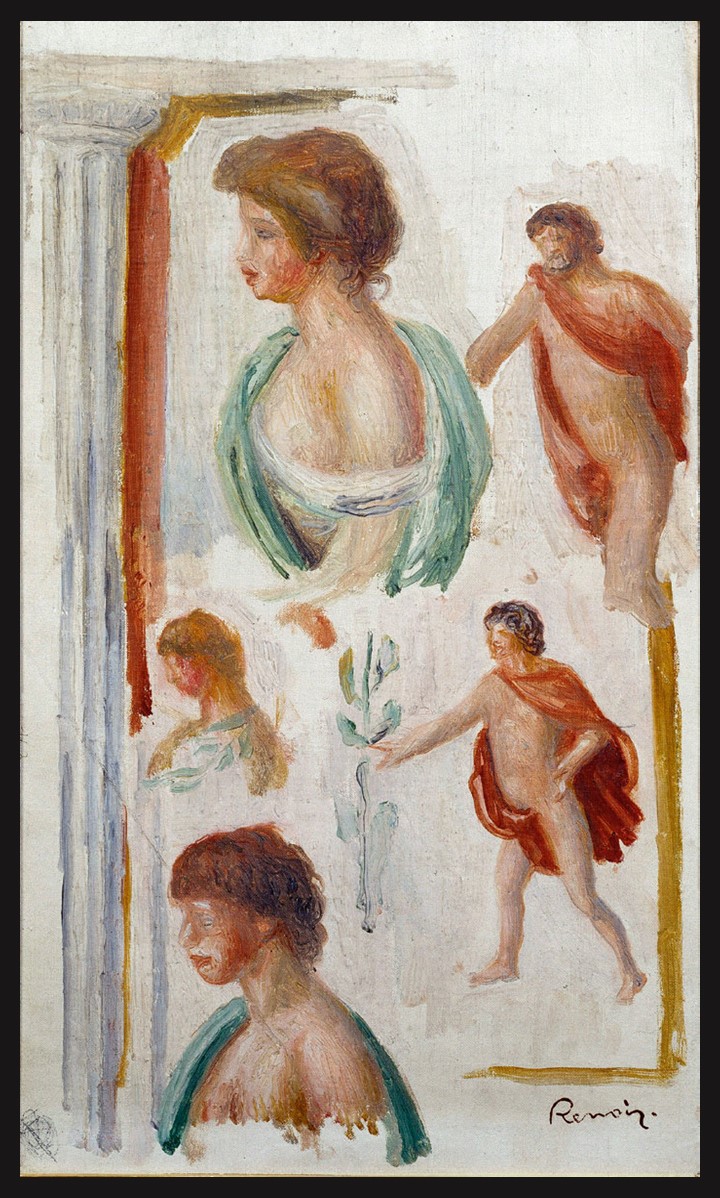
Panel for Oedipus: Jocasta, and Panel for Oedipus: King Oedipus
Both Panels: circa 1895, Oil on Canvas, 96.1 x 36.5 cm, Private Collection
https://www.christies.com/lot/lot-6452011?ldp_breadcrumb=back&intObjectID=6452011&from=salessummary&lid=1
Citizens of my beloved Thebes! See now your great Oedipus!
That famous man who knew the answers of great riddles. That man whose good fortune every man in Thebes envied! See now in what monstrous storm of misfortune he has fallen… Let’s not praise a man for his good Fate unless he has arrived at his final day, having escaped bad Fate… The last Chorus lines of Sophocles’ tragedy Oedipus Rex convey a sense of profound realization and acceptance of the futility of human efforts against fate and destiny. Do the paintings of Oedipus Rex and Jocasta by Renoir reflect Sophocles’ point of view? How did the great Impressionist artist decide to explore such a subject matter? https://bacchicstage.wordpress.com/sophocles/oedipus-rex/
The myth of Oedipus revolves around a tragic prophecy that foretells Oedipus, the son of King Laius and Queen Jocasta of Thebes, would kill his father and marry his mother. In an attempt to avoid this fate, Oedipus is abandoned as a baby but is later adopted and raised by another royal family. Unaware of his true parentage, Oedipus grows up and, through a series of unfortunate events, unwittingly fulfills the prophecy by killing his father, King Laius, in a chance encounter on the road and subsequently marrying his mother, Queen Jocasta. When the truth is revealed, Jocasta tragically takes her own life, and Oedipus blinds himself in horror and shame. The Oedipus myth explores themes of fate, free will, and the inevitability of destiny, serving as a classic example of Greek tragedy.
Sophocles’ Oedipus Rex stands as a timeless masterpiece of Greek tragedy, skillfully weaving a narrative that delves into the complexities of fate and the human condition. The play’s exploration of the inevitable clash between individual free will and the predetermined course of destiny is masterfully executed. The intricate use of dramatic irony, the relentless pursuit of truth, and the psychological unraveling of Oedipus and that of his mother Jocasta, contribute to the play’s enduring impact, making it a powerful and thought-provoking work that continues to captivate audiences and provoke contemplation on the intricacies of human existence.
These characteristics of drama seem to have inspired none other than the famous Impressionist artist Pierre-Auguste Renoir, who, in 1895, created two panels moved by Sophocles’ tragedy, depicting the protagonists of the play, Oedipus Rex, and Jocasta.
When viewed side-by-side, Christie’s experts tell us, Renoir’s two panels depicting Jocasta and Oedipus illustrate the full tension of the tragedy, their bodies seeming to push away from one another, whilst an unseen magnetic connection– an allegory for the inescapable strength of the prophecy– pulls them together. Renoir skillfully employs dynamic poses to enhance the drama of the narrative, and his vibrant choice of red alludes to the bloodshed in the tale. The artist embellishes the central figures on both panels with grisaille bas-reliefs and trompe l’oeil imitation of columns and stone, a rare example of Antique-inspired decoration within the artist’s oeuvre. https://www.christies.com/lot/lot-6452011?ldp_breadcrumb=back&intObjectID=6452011&from=salessummary&lid=1

Panel for Oedipus: Jocasta, and Panel for Oedipus: King Oedipus
Both Panels:circa 1895, Oil on Canvas, 96.1 x 36.5 cm, Private Collection
https://www.christies.com/lot/lot-6452011?ldp_breadcrumb=back&intObjectID=6452011&from=salessummary&lid=1
https://www.mutualart.com/Artwork/Panneau-pour-Odipe–Odipe-roi/676741683B0A87196FE13FBA024B87C8
Both paintings are indicative of Pierre-Auguste Renoir’s interest in the world of Antiquity, and particularly his reaction to the Pompeiian wall paintings he saw, and deeply admired, when he visited Italy in the fall of 1881 to mid-January 1882. In an 1882 letter to Mme George Charpentiere, he wrote… J’ai beaucoup étudié le Musée de Naples, les peintures de Pompéi sont extrêmement intéressantes à tous points de vue… https://chat.openai.com/c/c667ff6c-ca07-41ec-a3b0-29c824c174c3 Renoir’s Trip to Italy by Barbara Ehrlich White, The Art Bulletin, Vol. 51, No. 4 (Dec., 1969), pp. 333-351 (29 pages) p.350

https://www.palazzoroverella.com/renoir-alba-di-un-nuovo-classicismo/
Mythology, figures of ancient tragedy, (Project for Oedipus), 1895, oil on Canvas, 41,2 x 24,4 x 2 cm, Musée Picasso, Paris, France
https://www.palazzoroverella.com/renoir-alba-di-un-nuovo-classicismo/
The paintings of Oedipus and Jocasta were part of a commission by Paul Sébastien Gallimard, one of the artist’s most important patrons, and a close friend. They were meant to decorate a room in Gallimard’s country house, dedicated to Greek theatre. Once more quoting Christie’s experts Renoir’s panels reveal a combination of influences, from Ancient wall painting, to Louis XVI panelling and the Directoire style of furniture and ornament. A related study depicting mythological figures that Renoir worked on for this commission is now in the collection of the Musée Picasso in Paris and was previously owned by Pablo Picasso himself. For reasons that remain unknown, the room was never completed and the panels remained in Renoir’s studio until the artist’s death. https://www.christies.com/en/auction/ancient-to-modern-art-from-the-mougins-museum-of-classical-art-part-i-29973/
Both paintings were auctioned by Christie’s on the 7th of December 2023 (Ancient to Modern Art from the Mougins Museum of Classical Art).
For a Student Activity inspired by Oedipus Rex and Jocasta by Renoir, please… Check HERE!